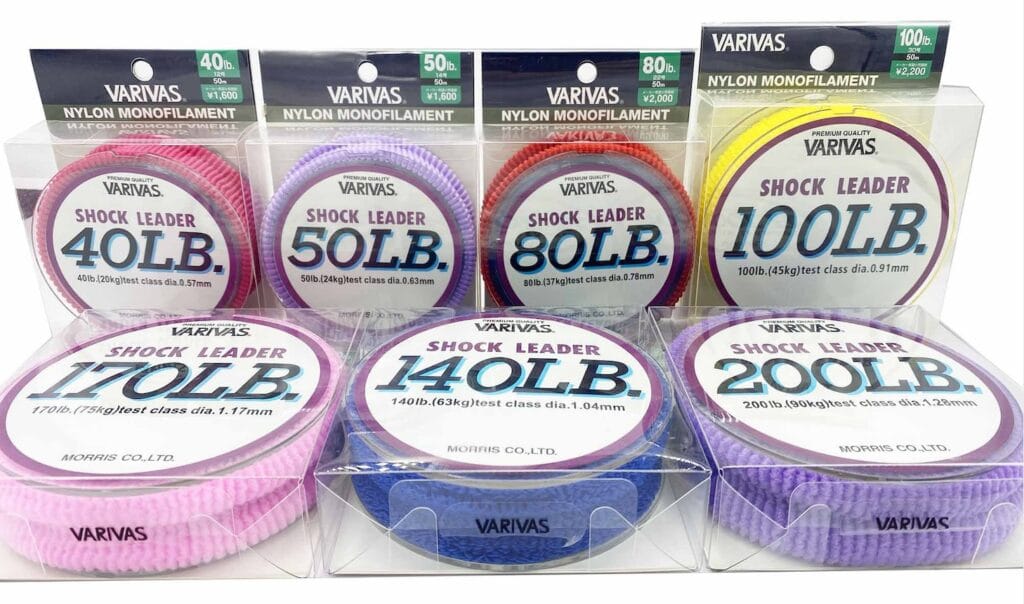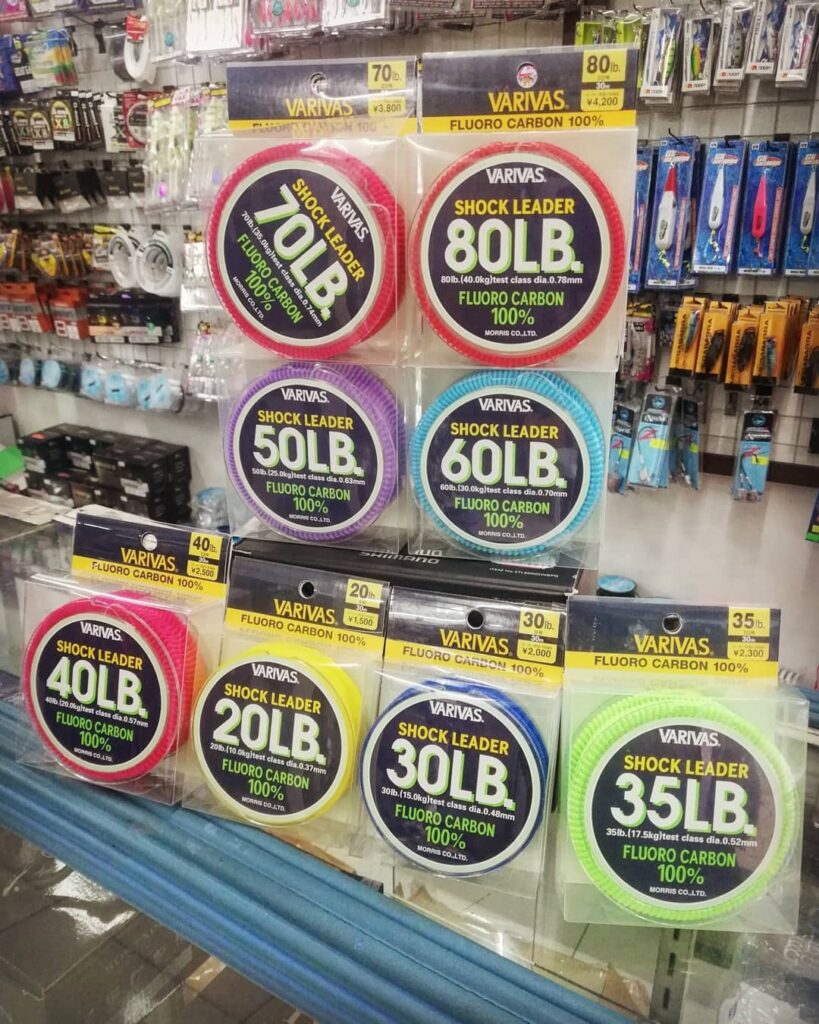Scratching your head figuring out which is the better leader material, fluorocarbon or mono? We’ll discuss the pros and cons of each leader type to help you figure out if there is a one line fits all leader for all our fishing needs.
Fluoro vs Mono: The Great Debate
Whether at tackle shops, fishing lodges, on boats or online, anglers from around the world have different opinions about fishing tackle. Rods, reels and lures are a popular topic amongst anglers of all levels due to the amount of options available and opinions on all sorts of tackle are based on personal experience, word of mouth or internet knowledge. One of the most heated debates are about which leader line is the best: monofilament of fluorocarbon?
To begin, lets differentiate the competitors from each other and see what makes each material unique. Later on we’ll list down the pros and cons of each leader material for a side-by-side review to find out who the clear winner is.
Let us begin with old and reliable monofilament.
Monofilament
Monofilament fishing line first came about in the 1950s. The main component of this type of fishing line is “nylon”. It was strong, flexible, translucent and cheap. Everything a fisherman could want in a fishing line. Monofilament – if broken down is “mono” or singular and filament, meaning that it is made from a single strand of melted nylon extruded into a long and cylindrical shape resulting in the fishing line we know and love.
We won’t go into much detail about how monofilament line is made and what its chemical components are but a key point to note is that Fluorocarbon is technically a monofilament line as well. Let’s proceed to Fluorocarbon.
Fluorocarbon
Fluorocarbon is a type of monofilament fishing line made out of PVDF (polyvinyldenefluoride). As a type of monofilament, it is also made the same way, with melted PVDF extruded into long cylinders. The discovery of this fishing line was in some ways an accident.
Back in the 1960s, in a car paint factory in Japan, workers were attempting to use the fluorocarbon “film” to make auto paint more UV resistant. As we all should know by now, there will be an angler lurking around having fishing on his mind 24/7. Lo and behold, Mr. Yoshi, an angler working in this factory saw the fluorocarbon film and saw a potential fishing line substitute. This factory was called the Kureha company and soon after released a new fluorocarbon fishing line under the name Seaguar.
Enough of the history and facts about each line and let us proceed to their inherent strengths and weaknesses.
STRENGTH TEST
Diameters and accurate laboratory strength tests aside, monofilament will have a higher overall breaking strain test result than fluorocarbon. Knot strength winner will also go to monofilament in this regard. But we have to discuss and consider other line characteristics first in order for everyone to understand which line is stronger in practical usage.
STRETCH OR ELASTICITY
Mono has greater elasticity than fluorocarbon. When you pull monofilament and release it, the line will bounce back to its original form. This elasticity or stretchiness is one of the key selling points of monofilament leaders as it acts as a shock absorber to your already stiff and non-elastic braided main line. It acts as a buffer for when your drag settings are super tight and you get an extremely big hit. No excessive tension between fish and angler may result in a better hook up to land ratio.
Now fluorocarbon also stretches but is not elastic. Meaning it doesn’t bounce back to its original length or form once pulled. This lack of elasticity is both good and bad. Good because it gives us anglers a more “solid” or sensitive feel of the lure or hooked fish. Bad because there is no “give” in both the main line and leader, and when stretched to its maximum capacity, the leader then becomes weaker.
LINE DENSITY
Fluoro has greater density, making it harder, stiffer and more abrasion resistant. With these three characteristics, you’d be sold on fluorocarbon any day of the week as they all contribute to the overall strength of the leader.
Mono is less dense, absorbs water and is prone to abrasion damage. Scary stuff considering this will be part of your line that is connected to the fish. So while mono has greater strength when new, after factoring in UV damage plus wear and tear, fluorocarbon has an edge when it comes to durability.
Since fluoro is more dense, even denser than water, it sinks. The opposite is now true for monofilament as it floats or suspends. Monofilament will eventually absorb water and after enough time, will eventually sink as well.
If you are going for technique specific use like subsurface fishing and if you need to get your lures down deeper, fluorocarbon has the edge on this aspect.
ABRASION RESISTANCE
Again, with a denser characteristic, fluorocarbon has a higher level of abrasion resistance. It can withstand more nicks, scratches from teeth, gills and fins while fishing and still maintain its strength. If you are fishing over coral and other sharp shallow structure, fluorocarbon will be the best choice. Although it won’t matter too much when an angry GT takes you to the shallows and cuts you off. Fluoro or mono are no match for a bus GT and reef.
KNOT-ABILITY AND STRENGTH
Monofilament catches up and is now neck and neck with fluorocarbon! Mono wins in knot-ability and knot strength by miles.
Being stiffer than mono, tying knots with fluorocarbon needs some extra care and attention. Each turn of your PR or FG knot should be seated properly. Tightening every few turns is key, then gradually pulling the knot tightly after wetting with spit to set the knot.
Mono also requires care and attention when knotting but is more forgiving. It is a softer line and is more forgiving that even 100lb test leaders and heavier can be knotted to terminals and lures easily and effectively.
Big and aggressive saltwater fish don’t really mind thick and visible leaders, you’ll be more worried about the breaking strength than underwater visibility.
VISIBILITY
Possibly the most common misconception in fishing line is that fluorocarbon is invisible to fish. It is true that the refractive light index of fluoro line is close to that of water, hence the apparent invisibility to fish, but my personal opinion is this may just be the work of marketing rather than real world experience, but I’ve yet to interview a caught fish, so I can’t really say what’s visible or not in the fish’s eyes.
It does give us a slight confidence boost when the fish are finicky and spooky. Changing to a fluorocarbon leader that is “invisible” may be the key to catching that overly spooky GT hanging around that 20ft tiger shark by the dropoff…
FLUORO LEADERS
Pros:
- Stiffer
- Minimal stretch
- High Abrasion resistance
- Smaller diameter than mono of same breaking strength
- Sinks faster than mono
Cons:
- More expensive
- Harder to tie knots with
- Needs regular replacing. After being stretched too much, it loses its strength
MONO LEADERS:
Pros:
- Cheap
- Soft and manageable
- Elasticity acts as shock absorber
- Easier to tie knots with
- Stronger knot strength
- Floats
Cons:
- Line memory
- More prone to abrasion damage
- Thicker in comparison to fluorocarbon with the same breaking strength
Conclusion
Both leader materials have their place in different situations as fishing is always situational. Big and aggressive saltwater fish don’t really mind thick and visible leaders, you’ll be more worried about the breaking strength than underwater visibility. You’ll also love to have some give or stretch when hooked up to 50kg fish trying to pull you off the boat. The stiffer leaders are better when you need the sensitivity when deep water jigging and it helps impart sharp and fast movements that attracts your targeted fish.
It all boils down to personal opinion and real-world experience. If you have the capability to purchase both kinds of leader material for your fishing, I highly recommend that you do so. It just gives you so much more options and a wider range of rigging techniques. But if like me, your have only so much space for spare spools of leader material in your bag, I will choose monofilament for its overall usefulness, cost, reliability and ease of use. Have I said that it’s cheaper? Yes, I think I’ve said it a few times. Monofilament might be the winner now, but I am 100% sure that this debate will go on and on until new fishing technology develops a close to perfect fishing line. Still waiting for it.
Photo credit: fishingstation.com.au
If you want to experience landing your fish of a lifetime, BOOK NOW a Vanuatu fishing adventure with Ocean Blue Fishing!
Call us now at 1300 564 616 or at (INTL) +61 436 020322 or you may also contact us through our website at https://www.oceanbluefishing.com/enquire

